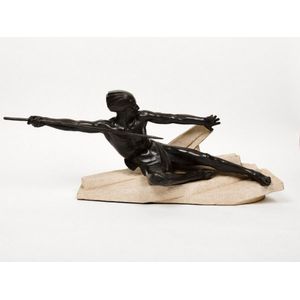Art Deco Lady Feeding Birds Spelter Figure
You must be a subscriber, and be logged in to view price and dealer details.
Subscribe Now to view actual auction price for this item
When you subscribe, you have the option of setting the currency in which to display prices to $Au, $US, $NZ or Stg.
- Spelter - Spelter was the name given to an alloy of zinc and brass or copper used in the 19th century for statuary and lighting. It is a brittle bluish-white metal. It was used as a cheap replacement for bronze, but being brittle easily breaks and can't be repaired. When finished it can often be mistaken for bronze, but if discreet a scratch on the base displays shows a greyish colour, the metal is spelter, if a golden colour the metal is most likely bronze.
- Art Deco Period - The Art Deco period was a cultural movement that emerged in the 1920s and 1930s, and was characterized by its emphasis on modernism, luxury, and elegance. The name "Art Deco" comes from the Exposition Internationale des Arts Décoratifs et Industriels Modernes, a large exhibition held in Paris in 1925 that showcased the latest trends in decorative arts.
Art Deco was a reaction against the ornate and elaborate styles of the previous era, and reflected a new modern sensibility. It was characterized by streamlined, geometric shapes, bright colours, and the use of new materials such as chrome, glass, and Bakelite. Art Deco designers sought to create a sense of luxury and sophistication, often incorporating expensive materials such as ivory, marble, and rare woods.
Art Deco had a significant impact on a wide range of artistic fields, including architecture, fashion, graphic design, and interior design. Some of the most iconic examples of Art Deco architecture include the Empire State Building in New York City, the Hoover Building in London, and the Palais de Chaillot in Paris.
The Art Deco period came to an end in the 1940s, as World War II and changing cultural trends led to a shift in artistic styles. However, Art Deco remains an important influence on design and art, and continues to be celebrated for its modernist sensibility and glamorous aesthetic.
This item has been included into following indexes:
Visually similar items

An Art Deco spelter figure of a huntress, circa 1930s, in bronzed spelter depicting a classical maiden in draping attire, her left hand holding a bow and poised on one knee ready to shoot, raised on an onyx and black marble plinth; unmarked, height 44 cm,

Max Le Verrier (French, 1891-1973), bronze figure of a man with spear mounted on a shaped stone base, base signed 'M Le Verrier'. Height 40 cm, width 100 cm, depth 30 cm

Fernand Ouillon-Carrere (French). Sword dancer, c. 1919. Patinated bronze sculpture of a nude, her hair dressed in two braided cinnamon buns, resting on a circular bronze socle with four swords and stepped green onyx base, signed 'F. Ouillon Carrere 1919'.

Royal Copenhagen bronze figure of a dancer of girl in ballet pose, arm out and leg stretched standing on tipitoe, on a timber base, and plaque marked by S.G Kelsey '75 edition 225/300, height 24 cm, width 25 cm, depth 7 cm
